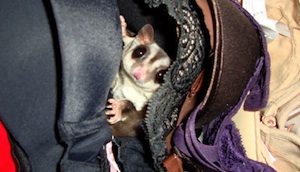 Glider proofing is a very important step you need to take before you bring your new sugar gliders home. Providing a safe environment for you sugar gliders in your new home should be a top priority. People often ask me about glider proofing, so I wanted to write an article about this to give you some guidelines.
Glider proofing is a very important step you need to take before you bring your new sugar gliders home. Providing a safe environment for you sugar gliders in your new home should be a top priority. People often ask me about glider proofing, so I wanted to write an article about this to give you some guidelines.
At a minimum, you will need to glider proof one room in your house where you can let your gliders out of their cage to play. However, it is a very good idea to glider proof your whole house, just in case your gliders were ever to get out of their cage. They are definitely capable of making an escape because they have opposable thumbs and have been known to figure out how to open their cage doors.
A good practice is to always keep the door closed in the room where your keep the cage. That way if your gliders were ever to escape, you would be able to confine them in that room. It will be a lot easier to find them in one room than if they were to gain access to your entire house. You would be surprised at how many hiding spots there are in your house.
Also check the door to that room to see if there is enough space to squeeze through at the bottom. You can roll up a towel and put it against the bottom of the door or buy a draft guard to seal up that space. Any more than half an inch space at the bottom should be covered up because they can squeeze through.
If your glider were to escape from the cage, don’t panic! They will usually come out on their own when they get hungry.
One of the biggest dangers in your home is the toilet. You want to make sure to keep the lid down at all times and keep a sign on it if other members of the family tend to forget. Although gliders can swim, they get stuck in toilets because the ceramic is too smooth for them to climb out of and they quickly become exhausted and drown.
Some people also make little ladders out of wire mesh and keep them in the toilet as a security measure. Gliders can even drown in a bowl or cup of liquid, so make sure there is no standing water left out where they could fall in and get trapped.
If you have ever had to baby proof a home, glider proofing is very similar. Many of the dangers a home presents for a toddler are exactly what you need to protect a glider from. That includes plugging up electrical sockets and keeping electrical cords out of reach.
The other kinds of issues that would be unique to gliders would be any holes in walls or furniture. Your glider will be able to fit into small crevices, and those spots make excellent nesting areas. Remember that gliders hang out in the hollows of trees in the wild, so they would naturally be attracted to small spaces in your home where they can hide out during the day.
Go around the house and inspect walls, furniture, cabinets, etc. for any gaps or holes. Plug up any holes you find to make sure your glider can’t get in. Folding furniture in particular, such as folding beds or recliners can make good hiding spots.
Household chemicals can be dangerous to gliders, and because they are such small animals, it doesn’t take much to harm them. Some houseplants are also toxic to them, so it is easiest to remove plants from the home if you aren’t sure whether they are safe.
If you want a surefire way to spot any troublesome areas in your home, you can let your glider explore and watch what kinds of trouble they try to get into. This is a great way to find things that you might not have otherwise noticed.
I hope this article gave you a good starting point for glider proofing your home. This isn’t an all inclusive list though, so make sure to be thorough as you go through your home and check for any dangers. It is hard to make a complete list because everyone has different homes and different things in their homes. Use your best judgement and if you aren’t sure about whether something is glider-safe, it is better to be safe than sorry and just keep it away from them.
Leave a Reply